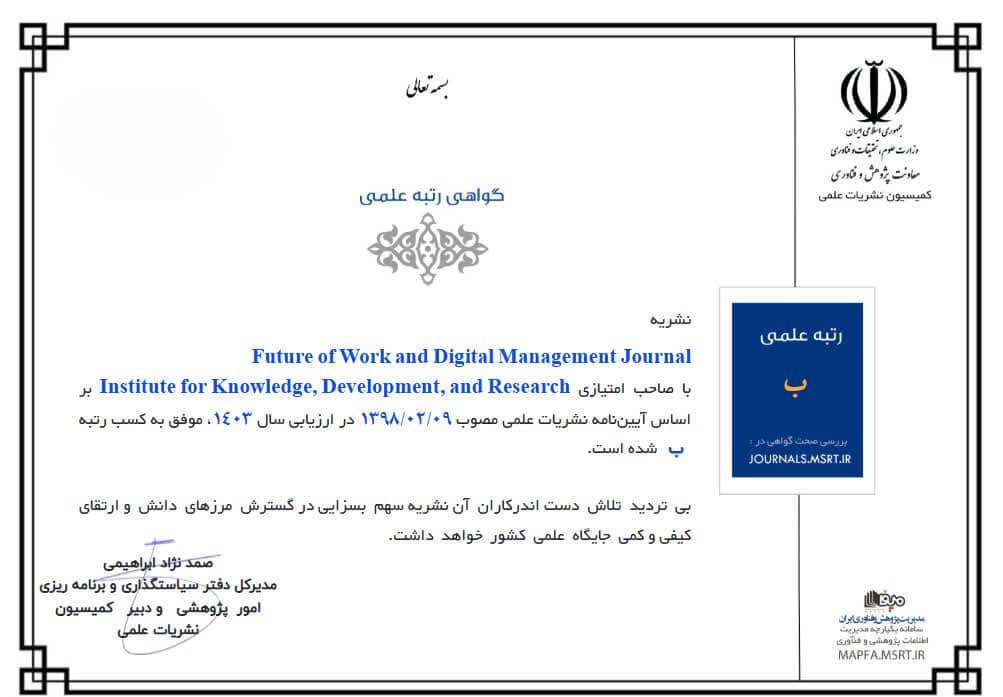Identification of Agents in an Agent-Based Simulation Model for Fraud Detection in the Banking System to Develop Scenarios
Keywords:
Agent-based modeling; fraud detection; banking system; credit fraud; customer behavior; monetary policy; scenario analysisAbstract
The objective of this study is to design and validate an agent-based simulation model for fraud detection in the banking credit ecosystem by identifying core agents, defining their attributes and behaviors, and testing system resilience under multiple economic scenarios. This research employed a qualitative–computational approach. Expert interviews with banking professionals and academic specialists were conducted to identify key agents, attributes, and relationships within the credit system. The agent-based simulation was then designed around three core agents: Customers, Banks, and the Central Bank. Each agent was assigned distinct financial and behavioral attributes, and their interactions were formalized through computational rules. Customer repayment behavior was modeled by combining financial capacity indicators (income, debt-to-income ratio, FICO score, revolving utilization) with behavioral intention (willingness to pay). Banks adapted their lending policies based on observed defaults, while the Central Bank influenced the system through macroeconomic variables such as inflation and unemployment. Finally, scenario analysis was applied to test the model under optimistic, realistic, and pessimistic macroeconomic conditions. The findings indicated that repayment decisions are were primarily influenced by the combination of behavioral intention (weighted at 70%) and financial capacity (weighted at 30%). Inflation and unemployment substantially reduced repayment capacity, confirming the importance of macroeconomic pressures in fraud emergence. Banks demonstrated adaptive responses by tightening or loosening credit policies depending on observed defaults. Scenario analysis revealed that in optimistic environments defaults were minimal; in realistic conditions, defaults were moderate and policy adjustments were balanced; and in pessimistic environments, defaults rose sharply, forcing restrictive credit strategies. The agent-based model successfully captured the dynamic interplay of individual behavior, institutional policy, and macroeconomic shocks in fraud detection within the credit system. Its robustness across scenarios demonstrates the utility of agent-based simulation as a complement to machine-learning methods, offering a tool for banks and regulators to anticipate fraud risks and test policy interventions under varying economic conditions.
Downloads
References
[1] R. Zhang, "Pre-Trained Online Contrastive Learning for Insurance Fraud Detection," Proceedings of the Aaai Conference on Artificial Intelligence, vol. 38, no. 20, pp. 22511-22519, 2024, doi: 10.1609/aaai.v38i20.30259.
[2] F. D. Narulita, R. N. Baderi, and H. Hwihanus, "The Impact of Fraud on the Detection of Fraud in Financial Statements and Discretionary Accruals (Meta-Analysis Study)," Journal of Advances in Accounting, Economics, and Management, vol. 1, no. 4, pp. 1-16, 2024, doi: 10.47134/aaem.v1i4.348.
[3] P. Sure, "Feature Selection Techniques for Enhancing Credit Card Fraud Detection Performance: A Hybrid Metaheuristic Approach Using Nature-Inspired Algorithms," International Journal for Research in Applied Science and Engineering Technology, vol. 12, no. 2, pp. 1185-1194, 2024, doi: 10.22214/ijraset.2024.58549.
[4] P. O. Shoetan, "Transforming Fintech Fraud Detection With Advanced Artificial Intelligence Algorithms," Finance & Accounting Research Journal, vol. 6, no. 4, pp. 602-625, 2024, doi: 10.51594/farj.v6i4.1036.
[5] S. S. Sulaiman, "Credit Card Fraud Detection Using Improved Deep Learning Models," Computers Materials & Continua, vol. 78, no. 1, pp. 1049-1069, 2024, doi: 10.32604/cmc.2023.046051.
[6] S. Rout, "Fraud Detection Using Deep Learning," International Journal of Electrical and Data Communication, vol. 5, no. 1, pp. 07-11, 2024, doi: 10.22271/27083969.2024.v5.i1a.37.
[7] O. Odeyemi, "Reviewing the Role of AI in Fraud Detection and Prevention in Financial Services," International Journal of Science and Research Archive, vol. 11, no. 1, pp. 2101-2110, 2024, doi: 10.30574/ijsra.2024.11.1.0279.
[8] M. Mahmoudi and M. Shahrokh, "Machine-learning in Fraud Detection," 2024.
[9] F. Bou Reslan and N. Jabbour Al Maalouf, "Assessing the Transformative Impact of AI Adoption on Efficiency, Fraud Detection, and Skill Dynamics in Accounting Practices," Journal of Risk and Financial Management, vol. 17, p. 577, 2024, doi: 10.3390/jrfm17120577.
[10] A. Cherif, H. Ammar, M. Kalkatawi, S. Alshehri, and A. Imine, "Encoder–decoder graph neural network for credit card fraud detection," Journal of King Saud University-Computer and Information Sciences, vol. 36, no. 3, 2024, doi: 10.1016/j.jksuci.2024.102003.
[11] A. Cherif, A. Badhib, H. Ammar, S. Alshehri, M. Kalkatawi, and A. Imine, "Credit card fraud detection in the era of disruptive technologies: A systematic review," Journal of King Saud University-Computer and Information Sciences, vol. 35, no. 1, pp. 145-174, 2023, doi: 10.1016/j.jksuci.2022.11.008.
[12] P. K. R. Hole, "Fraud Detection and Prevention in E-Commerce Using Decision Tree Algorithm," International Journal for Research in Applied Science and Engineering Technology, vol. 12, no. 4, pp. 2187-2196, 2024, doi: 10.22214/ijraset.2024.60307.
[13] M. T. Aras, "A Multi-Modal Profiling Fraud-Detection System for Capturing Suspicious Airline Ticket Activities," Applied Sciences, vol. 13, no. 24, p. 13121, 2023, doi: 10.3390/app132413121.
[14] S. K. Hashemi, S. L. Mirtaheri, and S. Greco, "Fraud Detection in Banking Data by Machine-learning Techniques," IEEE Access, vol. 11, pp. 3034-3043, 2023.
[15] M. N. Ashtiani and B. Raahemi, "An Efficient Resampling Technique for Financial Statements Fraud Detection: A Comparative Study," 2023, pp. 1-7, doi: 10.1109/ICECCME57830.2023.10253185.
[16] M. Asadi and A. Rad, "Fraud Detection in Banking Transactions Using Hyperparameter Optimization of the Support Vector Machine Algorithm," 2023.
[17] N. Prabhakaran and R. Nedunchelian, "Oppositional Cat Swarm Optimization‐Based Feature Selection Approach for Credit Card Fraud Detection," Computational Intelligence and Neuroscience, vol. 2023, no. 1, 2023, doi: 10.1155/2023/2693022.
[18] H. Majboori Yazdi, S. A. Khalifeh Soltani, and R. Hejazi, "Developing a Fraud Detection Model in Forensic Accounting," (in Persian), Biannual Scientific Journal of Governmental Accounting, vol. 9, no. 18, pp. 1-32, 2023.
[19] A. K. Omeir, D. Vasiliauskaitė, and E. Soleimanizadeh, "Detection of financial statements fraud using Beneish and Dechow models," Journal of governance and regulation, vol. 12, no. 3, pp. 334-344, 2023, doi: 10.22495/jgrv12i3siart15.
[20] T. Sadeghi and A. Nodehi, "Fraud Detection in Bank Cards Based on Image Processing Using Machine-learning Algorithms," 2023.
[21] S. Mehrani and A. Rahimipour, "Optimizing the Beneish Fraud Model in Predicting Financial Statement Restatements Using a Combination of Neural Networks and Genetic Algorithms," Journal of Accounting and Management Auditing, vol. 54, pp. 73-87, 2025.
[22] H. Raza, "Factors Influencing Fraud Whistleblowing," Morfai Journal, vol. 4, no. 4, pp. 1281-1292, 2025, doi: 10.54443/morfai.v4i4.2324.
[23] G. Lai, "Artificial Intelligence Techniques for Fraud Detection," 2023, doi: 10.20944/preprints202312.1115.v1.
[24] B. O. Adelakun, "Enhancing Fraud Detection in Accounting Through AI: Techniques and Case Studies," Finance & Accounting Research Journal, vol. 6, no. 6, pp. 978-999, 2024, doi: 10.51594/farj.v6i6.1232.
Downloads
Published
Submitted
Revised
Accepted
Issue
Section
License
Copyright (c) 2025 Zahra Vakili, Ameneh Khadivar (Author); Seyyed Mohammad Ali Khatami Firouzabadi (Translator)

This work is licensed under a Creative Commons Attribution-NonCommercial 4.0 International License.







